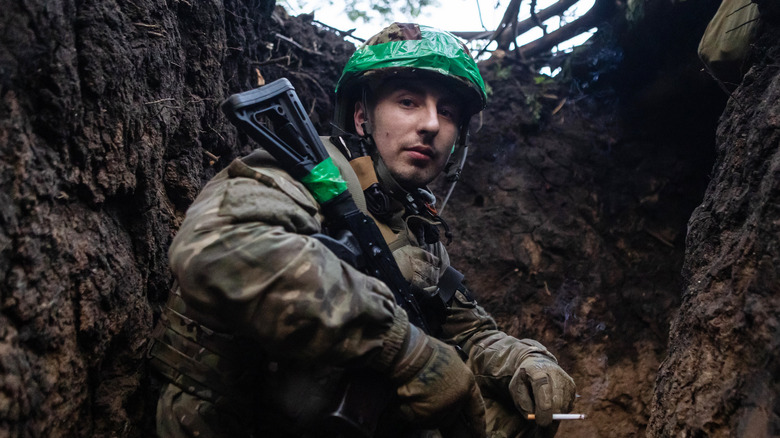The Future Of Trench Warfare: A Look At Ukraine's New AI-Controlled Turret
On September 4, 2023, Slava Ukraini shared a tweet on one of the latest additions to the arsenal of AI-powered military assets: the TGP combat module. Designed by devDROID, the TGP combat module eliminates several, crucial issues in trench warfare.
The Ukrainian tech company's innovative new remote technology has the capacity to detect target movements and their corresponding manpower. Afterward, it's said to be able to raise from the trenches, aim with increased precision, and calculate optimal ballistics.
💪 Ukrainian company devDroid has developed a remote control turret based on artificial intelligence.
The TGP combat module is placed in a trench for camouflage and protection, AI recognizes movements and manpower, then raises the weapon from the trench and signals the operator... pic.twitter.com/A6iAibTefN
— Slava Ukraini 🇺🇦 In Ukraine | News, Updates (@Heroiam_Slava) September 4, 2023
Set to work in tandem with an operator, the turret isn't designed to shoot autonomously. The remote-controlled machine requires confirmation from a human being before firing on its target. The TGP combat module marks the robotic automation solutions firm's first known military project.
At first, it can be tempting to view the AI-powered turret as an evolved targeting mechanism. However, it creates an interesting precedent for trench warfare mechanics in the future.
What AI-controlled turrets mean for trench warfare
In recent times, there have been many developments in military technology, especially when it comes to artificial intelligence. However, trench warfare remains a crucial strategy for infantry.
In March 2023, the New York Times published an article sharing the experiences of Ukrainian soldiers in the trenches from what the Ukrainian military calls the zero line position or the closest edge to the Russian military. After being unable to break through Ukrainian lines for almost a year, the Russian military forces re-strategized into smaller assault groups, which stormed Ukraine's front lines.
With trenches, soldiers could typically hide from bullets and prevent enemy forces from rushing in. However, the introduction of more advanced artillery, armored vehicles, and military drones has made trench warfare even more dangerous. In addition, it remains a traumatizing experience for soldiers, wherein they are at constant risk of lifelong injury or exposure to disease.
Eliminating the human risk element for the operator can help reduce decision-making errors and increase target precision. For example, operators are more likely to make sound decisions in a secure environment. Not to mention, it reduces the likelihood of using more firepower than necessary to eliminate a threat.
As technology continues to transform military operations, it's becoming even more obvious that the race to utilize robotics and artificial intelligence can make all the difference in modern warfare.

